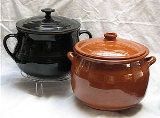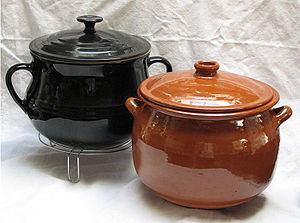
Olla
Encyclopedia
An Olla is a ceramic
jar, often unglazed
, used for cooking stew
s or soup
s, for the storage of water or dry foods, or for other purposes. Ollas have a short wide neck and a wider belly, resembling beanpot
s or handi
s.

The Latin word olla or aulla (also aula) meant a very similar type of pot in Ancient Roman pottery
, used for cooking and storage as well as a funerary urn to hold the ashes from
(literally "rotten pot"), cooked in an olla, dates back to the Middle Ages
.
 The Spanish settlers may have introduced the olla to Native American tribes, but it is likely they had developed a similar shape on their own. They often used unglazed pottery. The olla by its Spanish name has become associated with the region. It was used by settlers and natives both.
The Spanish settlers may have introduced the olla to Native American tribes, but it is likely they had developed a similar shape on their own. They often used unglazed pottery. The olla by its Spanish name has become associated with the region. It was used by settlers and natives both.
Among Southwestern Native American
tribes, ollas used for storing water often were made with narrow necks to prevent evaporation in the desert heat. The olla is used by the Kwaaymii
people, among many others, for cooking, storing water, serving meals and even nursing infants.
The term olla is also applied to regional basketry shaped with bulbous bodies and narrow necks. Olla baskets are commonly used by the Western Apache
, Shoshone
, and Yavapai
.
This irrigation technique was introduced to the Americas by Spanish
settlers in colonial
times. Agriculture and gardening specialists are teaching it, and olla use is making a comeback in New Mexico
and the American West. The state's master gardening program is spreading the word. An olla factory has been founded in Albuquerque
to produce the pots. It can be effective for homeowners to use in the desert climate. It has also been put to use by the Global Buckets project.
 In addition to utilitarian purposes, ollas are also produced by Native American and Mexican potters as artistic works. These ollas may be highly decorated and/or formed.
In addition to utilitarian purposes, ollas are also produced by Native American and Mexican potters as artistic works. These ollas may be highly decorated and/or formed.
Ceramic
A ceramic is an inorganic, nonmetallic solid prepared by the action of heat and subsequent cooling. Ceramic materials may have a crystalline or partly crystalline structure, or may be amorphous...
jar, often unglazed
Glazing
Glazing, which derives from the Middle English for 'glass', is a part of a wall or window, made of glass. Glazing also describes the work done by a professional "glazier"...
, used for cooking stew
Stew
A stew is a combination of solid food ingredients that have been cooked in liquid and served in the resultant gravy. Ingredients in a stew can include any combination of vegetables , meat, especially tougher meats suitable for slow-cooking, such as beef. Poultry, sausages, and seafood are also used...
s or soup
Soup
Soup is a generally warm food that is made by combining ingredients such as meat and vegetables with stock, juice, water, or another liquid. Hot soups are additionally characterized by boiling solid ingredients in liquids in a pot until the flavors are extracted, forming a broth.Traditionally,...
s, for the storage of water or dry foods, or for other purposes. Ollas have a short wide neck and a wider belly, resembling beanpot
Beanpot
The Beanpot refers primarily to a men's ice hockey tournament among the four major college hockey schools of the Boston, Massachusetts area, held annually since the 1952-53 season. The tournament gives the winner bragging rights over its cross-town rivals, and the quest for this highly sought-after...
s or handi
Handi
A handi is a deep, narrow-mouthed cooking vessel used in Indian, Bangladehi and Pakistani cooking. Because there are many specific Indian and Pakistani dishes cooked in this vessel, their names reflect its use, such as "handi biryani"....
s.
History

Antiquity
- Main article: Olla (Roman pot)Olla (Roman pot)In ancient Roman culture, the olla is a squat, rounded pot or jar. An olla would be used primarily to cook or store food, hence the word “olla" is still used in some Romance languages for either a cooking pot or a dish in the sense of cuisine...
.
The Latin word olla or aulla (also aula) meant a very similar type of pot in Ancient Roman pottery
Ancient Roman pottery
Pottery was produced in enormous quantities in ancient Rome, mostly for utilitarian purposes. It is found all over the former Roman Empire and beyond...
, used for cooking and storage as well as a funerary urn to hold the ashes from
Spain
In Spain, the popular dish olla podridaOlla podrida
Olla podrida is a Spanish stew made from pork and beans and an inconsistent, wide variety of other meats and vegetables, often including chickpeas, depending on the recipe used. The meal is traditionally prepared in a clay pot over several hours...
(literally "rotten pot"), cooked in an olla, dates back to the Middle Ages
Middle Ages
The Middle Ages is a periodization of European history from the 5th century to the 15th century. The Middle Ages follows the fall of the Western Roman Empire in 476 and precedes the Early Modern Era. It is the middle period of a three-period division of Western history: Classic, Medieval and Modern...
.
American Southwest

Among Southwestern Native American
Indigenous peoples of the Americas
The indigenous peoples of the Americas are the pre-Columbian inhabitants of North and South America, their descendants and other ethnic groups who are identified with those peoples. Indigenous peoples are known in Canada as Aboriginal peoples, and in the United States as Native Americans...
tribes, ollas used for storing water often were made with narrow necks to prevent evaporation in the desert heat. The olla is used by the Kwaaymii
Mission Indians
Mission Indians is a term for many Native California tribes, primarily living in coastal plains, adjacent inland valleys and mountains, and on the Channel Islands in central and southern California, United States. The tribes had established comparatively peaceful cultures varying from 250 to 8,000...
people, among many others, for cooking, storing water, serving meals and even nursing infants.
The term olla is also applied to regional basketry shaped with bulbous bodies and narrow necks. Olla baskets are commonly used by the Western Apache
Western Apache
Western Apache refers to the Apache peoples living today primarily in east central Arizona. Most live within reservations. The White Mountain Apache of the Fort Apache, San Carlos, Yavapai-Apache, Tonto Apache, and the Fort McDowell Mohave-Apache Indian reservations are home to the majority of...
, Shoshone
Shoshone
The Shoshone or Shoshoni are a Native American tribe in the United States with three large divisions: the Northern, the Western and the Eastern....
, and Yavapai
Yavapai people
Yavapai are an indigenous people in Arizona. Historically, the Yavapai were divided into four geographical bands that considered themselves separate peoples: the Tolkapaya, or Western Yavapai, the Yavapé, or Northwestern Yavapai, the Kwevkapaya, or Southeastern Yavapai, and Wipukpa, or Northeastern...
.
Use in irrigation
Because water seeps through the walls of an unglazed olla, these vessels can be used to irrigate plants. The olla is buried in the ground next to the roots of the plant to be irrigated, with the neck of the olla extending above the soil. The olla is filled with water, which gradually seeps into the soil to water the roots of the plant. It is an efficient method, since no water is lost to evaporation or run-off.This irrigation technique was introduced to the Americas by Spanish
Spain
Spain , officially the Kingdom of Spain languages]] under the European Charter for Regional or Minority Languages. In each of these, Spain's official name is as follows:;;;;;;), is a country and member state of the European Union located in southwestern Europe on the Iberian Peninsula...
settlers in colonial
Colony
In politics and history, a colony is a territory under the immediate political control of a state. For colonies in antiquity, city-states would often found their own colonies. Some colonies were historically countries, while others were territories without definite statehood from their inception....
times. Agriculture and gardening specialists are teaching it, and olla use is making a comeback in New Mexico
New Mexico
New Mexico is a state located in the southwest and western regions of the United States. New Mexico is also usually considered one of the Mountain States. With a population density of 16 per square mile, New Mexico is the sixth-most sparsely inhabited U.S...
and the American West. The state's master gardening program is spreading the word. An olla factory has been founded in Albuquerque
Albuquerque, New Mexico
Albuquerque is the largest city in the state of New Mexico, United States. It is the county seat of Bernalillo County and is situated in the central part of the state, straddling the Rio Grande. The city population was 545,852 as of the 2010 Census and ranks as the 32nd-largest city in the U.S. As...
to produce the pots. It can be effective for homeowners to use in the desert climate. It has also been put to use by the Global Buckets project.
Use in refrigeration
The olla is also useful for keeping water cool. When an unglazed olla is filled with water, the water permeates the clay walls of the vessel, causing the olla to "sweat". The evaporation of the sweat cools the olla and its contents. In the early 20th century, many ranches in the American Southwest used the practice of hanging an olla from a rope on the verandah in a shady breezy spot. Several hours after the olla was hung, it was cooled enough by evaporation to keep butter and milk safely cold.As works of art


